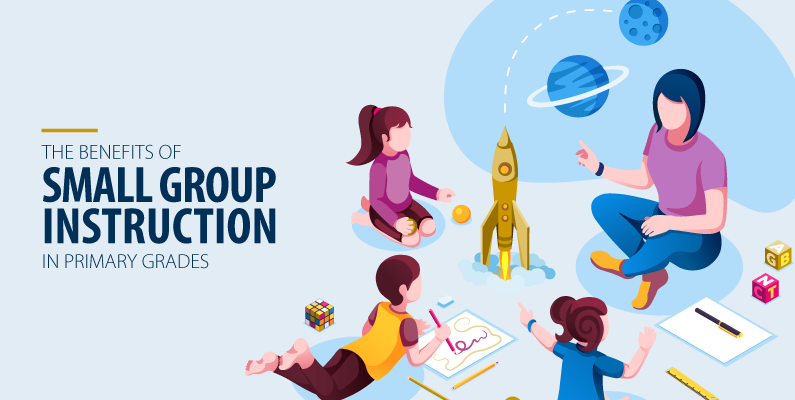The Benefits of Small Group Instruction in Primary Grades
| 5 Min Read

This blog post was written by guest contributor Halee Sikorski.
I’ve taught a variety of grades throughout my educational experience: fifth grade, third grade, and now first grade. One thing that has remained consistent is utilizing small group instruction in both my literacy and math blocks. There are many benefits to small group instruction, and it is very much possible to implement these strategies in the primary grades. It’s extremely collaborative, it allows for differentiation and individualized instruction, and there’s increased interest from your students. If you aren’t already utilizing small group instruction in your primary classroom, check out a few of my implementation tips to help you get started.
The first benefit of small group instruction is increased collaboration between peers. At first glance it may be nerve wracking to leave your students on their own while you work with a small group, but they quickly find assistance in each other. My own personal rule in my classroom is “Ask three before me.” This means, if students have a question while I’m working with a small group, instead of interrupting our mini lesson, they must ask three peers before coming to ask me. A majority of the time, their problems are resolved! Additionally, I try to work in a variety of games that allow them to practice skills with a partner or a small group. They enjoy working together and look forward to this part of the school day.
The next benefit of small group instruction, and perhaps the most important, is the fact that you’re able to differentiate activities and provide individualized instruction on a smaller scale for your students. I love being able to reach my students exactly where they are and guide them on a smaller scale. You will need to decide whether you want to group your students heterogeneously or homogeneously. There are pros and cons to each. I personally group my students homogeneously. I’m able to plan my teacher table at their exact reading level, or tailor instruction to certain math skills they may need assistance on. Differentiation and individualized instruction doesn’t stop at the teacher table, though. My students are able to continue working at their own level throughout the entire time we’re working on our reading or math centers. My favorite ways to incorporate this is through technology, individualized word lists for word work, different writing prompts, and even various games. The possibilities are endless! Some of my favorite technology tools for individualized practice include Freckle, Epic, RazKids, Prodigy, and ABCYa.
A final benefit of small group instruction is increased interest from students. My students love our center time and look forward to it each day. They appreciate being able to work on a variety of tasks and even meeting with me at the teacher table. By getting to know your students, you can select activities, passages or games that match their interests. Another idea for increasing student interest, is allowing them a mode of choice. When students are able to pick different activities they truly enjoy, they’ll be more engaged in the task, and will get more out of the activity. My students often have choice in the books they read and the technology websites they can practice on, and I always make sure to provide a few different options in the word work bin for practicing sight words or spelling words of the week.
Alright, I’ve got you hooked and you’re ready to try implementing small groups in your classroom this year, right? Here are a few implementation tips I’ve learned over the past few years. First, start small and practice, practice, practice. It took me almost a full week to introduce my reading stations to my first graders this year. I started by introducing one station each day and we practiced what that would look like. We discussed expectations together and reviewed them each day, and still review our expectations daily. Be firm at the beginning so your students really know the expectations, and they will rise to the occasion if you let them.
My next implementation tip involves picking one subject to try implementing small group instruction in, such as reading or math. Don’t burn yourself or your students out with too much change at once. It can seem overwhelming at first, so dip your toes into the water of small group instruction before diving in.
Additionally, I highly recommend using a slideshow to help you and your students stay organized. I list all of my students in their groups, and utilize a photo icon for each of their stations to help them know where they need to be and what they need to be working on. Make your slides even more effective by including a timer to keep your students on track.
Finally, try using resources or materials you already have. You don’t have to create a ton of new games and activities. The curriculum or resources you already have access to and have been utilizing is an easy and stress-free way to integrate small group instruction in your classroom.
Small group instruction allows for increased collaboration between peers, easy differentiation opportunities, individualized instruction, and increased interest. Once you get in the swing of things, I have a feeling you’ll never look back.
The best option to gain a better insight into how to best utilize innovative and practical resources in the classroom is to continue your education. By getting an online M.A. in Early Childhood Education, you’ll gain the skills and confidence to implement small group activities that much more effectively. At Concordia St. Paul, you’ll have the ability to develop productive collaboration activities. Learn more about the program today.
Halee Sikorski is an elementary teacher in Des Moines, Iowa. You can follow her on Instagram.